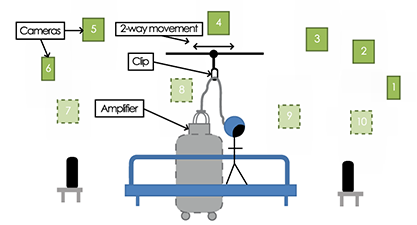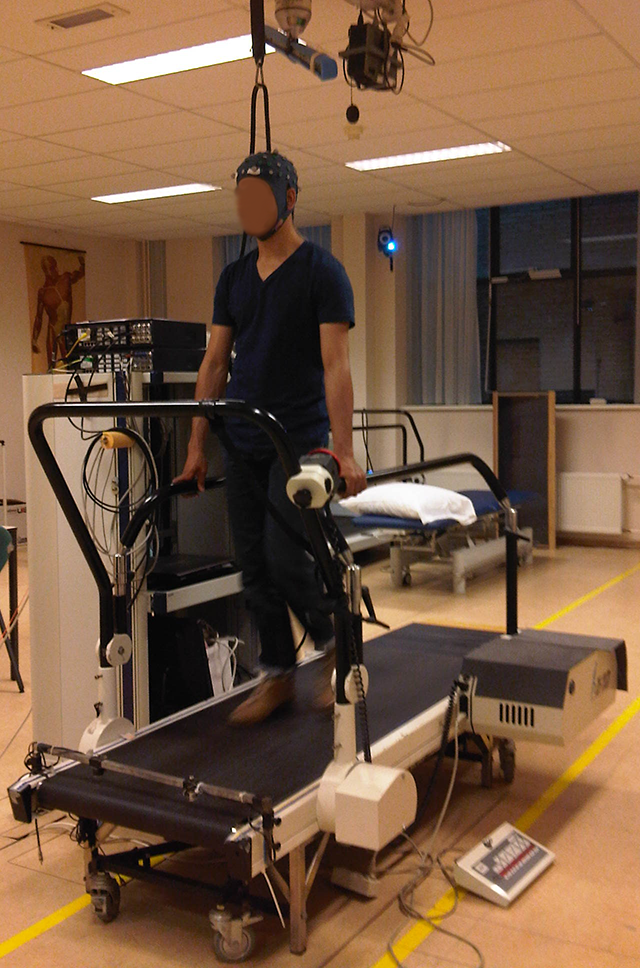Brain Computer Interface for walking rehabilitation
Online feedback for stroke gait rehabilitation

Brain-computer interface (BCI) research has been applied in motor rehabilitation. Most of these researches have focused on the upper body.
Only a few studies consider gait because of the difficulty of recording EEG during gross movements. However, for stroke patients the rehabilitation of gait is of crucial importance.
In this work, I investigated:
- An online setup for actual walking and an online BCI for imaginary walking
- Two studies comparing simple forward walking and a less automatic walking:
- Feasibility Study: Forward vs. Backward walking
- Online setup: Simple walking vs. Walking at varying speeds
Result
An online BCI for actual and imaginary walking was built and evaluated. The results showed a classification accuracy between walking and no walking higher than chance level. Higher performance was obtained for actual walking than for imaginary walking.


Markers for stepping were shown on a screen in front of the user. The interface was designed as a virtual extension of the treadmill that the user was walking on.
During calibration, stepping cues were shown as blue and orange. Each color corresponded to left and right foot, respectively. These colors were chosen as they are color-blind friendly.
Calibration data were used to select the best features for the BCI. The features used were power desynchronisation in the Electroencephalography mu, beta and mu+beta bands. With this data, a model was trained to classify between walking and no walking.
When testing of the interface, the user was given the same stepping cues as in the training phase, and feedback on their performance. Feedback on performance was provided as transparency levels. A more opaque color indicated that the machine clearly detected one of the two classes. The more transparent the color, the closer to chance level. In other words, the machine could not tell whether the participant was walking or not. This acted as biofeedback to encourage the participant to walk with a more defined pattern. Such encouragement is expected to be beneficial for rehabilitation.
The identification of walking patterns was done by using both intra-stride modulations changing within a gait cycle, and inter-stride modulations appearing whenever a person walks. Inter-stride modulations were the most successful to identify imaginary walking.
Method
A 64-electrode TMSi-REFA system was used to acquire Electroencephalography (EEG) from each user. Motion tracking was used to identify the stages of each gait cycle for calibration. Users were asked to walk on a treadmill, or to stand on it for the imaginary walking conditions. Fieltrip, and other custom Matlab functions were used to implement offline and online classifications.
First, I investigated if a BCI can be based on walking related desynchronisation features. Next, I tested the influence of complexity of the walking movements on the classification performance.
Two BCI experiments were conducted in which healthy subjects performed a cued walking task, a more complex walking task (backward or adaptive walking), and imagination of the same tasks. EEG data during these tasks was classified into walking and no-walking. The results from both experiments showed that despite the automaticity of walking and recording difficulties, brain signals related to walking could be classified rapidly and reliably. Classification performance was higher for actual walking movements than for imagined walking movements. There was no significant increase in classification performance for both the backward and adaptive walking tasks compared to the cued walking tasks. These results are promising for developing a BCI for the rehabilitation of gait.

Resulting academic publications and presentations
| Severens, M., Perusquía-Hernández, M., Nienhuis, B., Farquhar, J., Duysens, J., Using Actual and Imagined Walking Related Desynchronisation Features in a BCI, IEEE Transactions on Neural Systems and Rehabilitation Engineering, vol. 23, issue 5, pp.877-886. 2014. DOI: 10.1109/TNSRE.2014.2371391 | Download Cite |
| Perusquía-Hernández, M., Severens, M., Farquhar, J., Cuijpers, R.H., “A Brain-Computer Interface for Walking”. Poster presentation. BBCI Workshop 2012 on Advances in Neurotechnology. 2012. | Download |